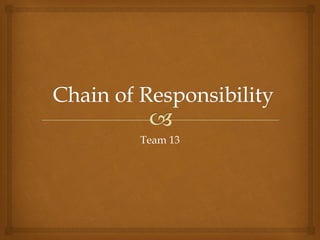
Chain of responsibility
- 1. Team 13
- 2. Introduction Behavioral design pattern. Uses a chain of objects to handle a request. Objects in the chain forward the request along the chain until one of the objects handles the request. Avoid coupling the sender of a request to its receiver by giving more than one object a chance to handle the request.
- 3. Class Diagram successor client Handler Request handleRequest() ConcreteHandler1 ConcreteHandler2 handleRequest() handleRequest()
- 4. Usage Several objects have similar methods that could be appropriate for the action that the program is requesting. One of the objects might be most suitable.
- 5. Usage (cont.…) Having new objects that want to add to the list of processing options while the program execution. When more than one object may handle a request and the actual handler is not know in advance
- 6. Implementation In brief, We create four objects that can either “Add”, “Subtract”, “Multiply” or “Divide”. Send two numbers and a command, that allow above four objects to decide which can handle the requested calculation.
- 7. Implementation Interface public interface Chain { void calculate(Numbers request); void setChain(Chain nextChain); } }
- 8. Implementation Numbers Class public class Numbers { private int _number1, _number2; private string _command; public Numbers(int number1, int number2, string command) { _number1 = number1; _number2 = number2; _command = command; } public int getNumber1() { return _number1; } public int getNumber2() { return _number2; } public string getCommand() { return _command; } } }
- 9. Implementation Addition Class Public Addition : Chain { private Chain _nextChain; public void calculate(Numbers request){ if (request.getCommand() == "add"){ Console.WriteLine(“Result: {0}",request.getNumber1()+request.getNumber2()); }else{ _nextChain.calculate(request);} } public void setChain(Chain nextChain){ _nextChain = nextChain; } }
- 10. Implementation Subtraction Class Public Subtraction : Chain { private Chain _nextChain; public void calculate(Numbers request){ if (request.getCommand() == "sub"){ Console.WriteLine(“Result: {0}",request.getNumber1()-request.getNumber2()); }else{ _nextChain.calculate(request);} } public void setChain(Chain nextChain){ _nextChain = nextChain; } }
- 11. Implementation Multiplication Class Public Multiplication : Chain { private Chain _nextChain; public void calculate(Numbers request){ if (request.getCommand() == "mul"){ Console.WriteLine(“Result: {0}",request.getNumber1()*request.getNumber2()); }else{ _nextChain.calculate(request);} } public void setChain(Chain nextChain){ _nextChain = nextChain; } }
- 12. Implementation Division Class Public Division : Chain { private Chain _nextChain; public void calculate(Numbers request){ if (request.getCommand() == "div"){ Console.WriteLine(“Result: {0}",request.getNumber1()/request.getNumber2()); }else{ “Unidentified Command! Please Check again...”} } public void setChain(Chain nextChain){ _nextChain = nextChain; } }
- 13. Implementation Demo Class class Demo{ public static void Main() { Chain chainCalc1 = new Addition(); Chain chainCalc2 = new Subtraction(); Chain chainCalc3 = new Multiplication(); Chain chainCalc4 = new Division(); chainCalc1.setChain(chainCalc2); chainCalc2.setChain(chainCalc3); chainCalc3.setChain(chainCalc4); Numbers request1 = new Numbers(10,5,"add"); Numbers request2 = new Numbers(10,5,"mul"); chainCalc1.calculate(request1); chainCalc1.calculate(request2); Console.ReadLine(); }
- 14. Pros & Cons Pros More efficient More flexible Refactor and change the code is easy Cons Handling isn't guaranteed
